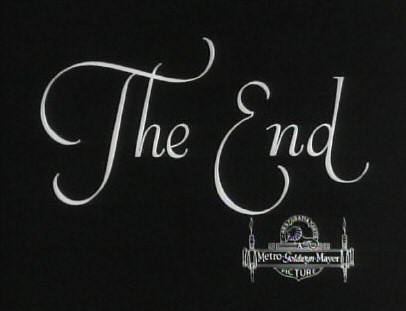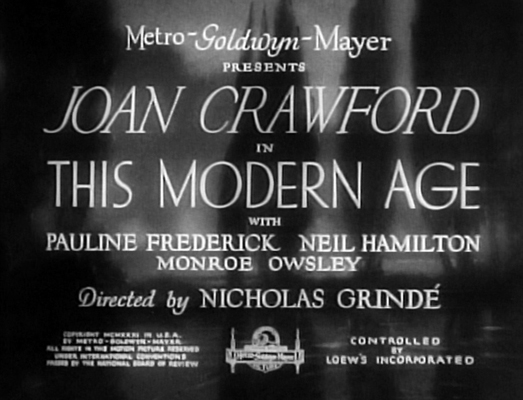
The Best of Everything
Encyclopedia Entry • Films Main
This Modern Age
1931

Critics' Reviews • Our Reviews • Movie Posters • Lobby Cards • Misc. Images
Click here to see photos from the film.
US release: 8/29/31.
DVD release: 4/6/10.
Cast: Joan Crawford (as "Valentine Winters"), Pauline Frederick, Neil Hamilton, Monroe Owsley, Hobart Bosworth, Emma Dunn, Albert Conti, Adrienne D'Ambricourt, Marcelle Corday.
Credits: From the story "Girls Together" by Mildred Cram. (Originally appeared in College Humor magazine, Feb. 1931.) Continuity and dialogue: Sylvia Thalberg, Frank Butler. Director: Nicholas Grinde. Camera: Charles Rosher. Editor: William LeVanway. Art Director: Cedric Gibbons. Costumes: Adrian.
Plot Summary: Despite the fact that they were playing mother and daughter, someone at MGM apparently felt that Pauline Frederick and Joan Crawford resembled each other too much, and a decision was made to lighten Crawford's hair to an unbecoming honey-blonde. That, alas, is the most novel aspect of This Modern Age, which wasn't all that modern even in 1931. Miss Frederick gives her usual fine performance, even if the situation does invite rather broad histrionics, but she is not given all that many opportunities to shine. In one important confrontation with daughter Crawford, the veteran silent star was not awarded a single close-up. They talk a lot in This Modern Age, but no one says much of interest and Neil Hamilton, in a role rather obviously created for a Robert Montgomery or Lew Ayres, is deathly dull and not the kind a girl would pine over for long. Later in life, Crawford, according to one of her biographers, implored her fans to simply "forget This Modern Age." ~ Hans J. Wollstein, All Movie Guide
Notes: • In production March - April 1931.• The film's working title was Girls Together, from the name of the short story on which it was based. (AFI page) • Joan's hair was dyed blonde to match the hair color of Marjorie Rambeau, who initially played the mother role. When Rambeau became ill and was replaced by the brunette Frederick, producers decided to avoid reshooting scenes and kept Joan as a blonde. (Quirk/Schoell) • The Catholic Church of Detroit banned the film.
|
|
Mordaunt Hall in the New York Times September 7, 1931 A flaxen-haired Joan Crawford is the principal figure in "This Modern Age," a pictorial attraction now at the Capitol. It is a film story which glides along merrily most of the time, but now and again it has its off moments. The main reason for the title is a carefree young man named Tony, who is given to reckless driving and drinking. In fact he is never actually sober, and occasionally he is beheld in his evening clothes at high noon making a call on his friends. Apparently he would sooner give a bottle of wine to a girl than a bouquet of flowers. Monroe Owsley does exceedingly well by the part of Tony. As for Miss Crawford, she gives a better portrayal here than she has in any of her previous talking pictures. As Valentine Winters she succeeds in being quite convincing in cheery and serious moments. A further asset to this production is Pauline Frederick, who figures as Diane, Valentine's divorced mother, who until the closing scenes is the mistress of a Frenchman named André de Graignon. Valentine turns up in Paris to see her mother, after being for many years in the custody of her father. It is not until the climax is reached that she learns of her mother's relations with de Graignon. An instance of implausibility is where Valentine first meets Bob, a Harvard football player and the son of well-to-do, conservative parents. Tony and Valentine are in an automobile which turns turtle after a crash. Bob, who is in another car, helps Valentine to crawl out of the wrecked conveyance. She talks to Bob as though nothing untoward had happened and a few moments later she thinks of Tony. No sooner is his name mentioned than the inebriated young man extricates himself from the overturned automobile. All thought of the accident is quickly dismissed, as neither Tony nor Valentine is hurt. But it is quite plain that cupid has scored, for from then on the narrative is chiefly concerned with the love affair between Valentine and Bob. When Bob and his father and mother go to see Valentine and Diane, their quiet game of bridge is rudely interrupted by Tony bursting into the house. He is followed by a group of friends, all presumably the worse for wine. Then there is trouble from de Graignon and the truth comes out concerning Diane. But the shadow-story tellers, as might be surmised, find a way to end matters satisfactorily. Neil Hamilton does very well as the noble Bob and Albert Conti rises to what is demanded of him as de Graignon. Nicholas Grinde, director of this picture, has done splendid work by his comedy, but his serious interludes might have been handled more effectively. Chester Hale's stage contribution, "Going! Going! Gone!" has some glamorous scenes and several good numbers. |
If you've seen This Modern Age and would like to share your review here, please e-mail me. Include a picture or avatar of yourself to accompany your review, as well as a star-rating (with 5 stars the best) and any of your favorite lines from the film.
|
Rating:
This Modern Age (1931) is a movie often overlooked in Joan's portfolio. The early 1930s initiated her slow journey from starlet and ingénue to acclaimed actress. Joan later sought, and won, meatier roles, for example, as Mary Turner in Paid. Sadie Thompson in Rain, or Letty Lynton in the eponymous movie. TMA's Valentine Winters---like the blonde locks Joan sports in this film---pales in comparison.
1931 was the year in which Joan's on- and off-screen affair with Clark Gable began, and unlike every other movie she released that year, there is no Gable, but rather Neil Hamilton, who plays high-society scion Bob Blake. (Hamilton was Joan's lover in 1931's Laughing Sinners, and had a long career in film and TV, but he's no Gable.) Bob's dad is played by Hobart Bosworth, most famous as John Gilbert's dad in the 1925 epic The Big Parade. Mrs. Blake is Emma Dunn, who was the mom of Jerry (Robert Montgomery) in Letty Lynton. They're good in limited screen time as the patrician Blakes who worry if Valentine and her mom are the sort of folks they want in the family.
I get the feeling that some of the cast and crew of TMA were from MGM's B team. For example, the director is Nick Grinde. Who?! Near as I can figure, he seems to have mostly directed B movies. Likewise, instead of someone like bestie Billy Haines---although his career had begun its slide---as the habitually besotted Tony, we get Monroe Owsley. (Although Owsley did have the unbelievable good fortune of acting with the most glamorous pre-Code leading ladies. Check out this list from the IMDb: Barbara Stanwyck in Ten Cents a Dance (1931); Claudette Colbert in Honor Among Lovers (1931); Gloria Swanson in Indiscreet (1931); Helen Twelvetrees in Unashamed (1932); Clara Bow in Call Her Savage (1932); Kay Francis in The Keyhole (1933); Bette Davis in Ex-Lady (1933); and Carole Lombard in Brief Moment (1933). Wow, excepting Bette Davis, that's the guest list for my dream dinner party! Unfortunately, Owsley's career petered out quickly and he died at the age of 37.)
Valentine's mom---whose "dark secret" threatens to put the kibosh on her daughter's nuptials---is played by Pauline Frederick, who garnered her greatest acclaim on the stage. Frederick was a last-minute addition who replaced Marjorie Rambeau when the latter took ill. (Frederick---among a legion of Broadway actors who ventured West at the dawn of the Talkies era---had an interesting life. Her 5 husbands put her perfectly betwixt Joan (4) and Gloria Swanson (6). She, too, died early, age 55, from asthma.) Frederick is very good in this film. Indeed, with more screen time, she may have stolen the picture from Joan. She only infrequently lapses into melodramatic overacting. I would like to think Joan learned a thing or two from working with Pauline.
It's a soaper. No deep or heavy themes. You know that the conflict will be magically resolved in the last reel, tears shed, lamentations made, lovers embrace, cue the final credits. Overall, an enjoyable movie. Would it have been better with Clarence Brown or George Cukor at the helm? Sure. But, at 68 minutes, it's fast paced, which I always consider a plus.
Rating:
Miss Crawford summed this movie up in one word…FORGET! I tend to agree. Maybe that would be a better title: “Forget This Modern Age”!
MGM supplied a nice title with potential, but the script was written in the MGM school nursery. It makes everyone bland and foolish, striving to pull our heart strings so that we should even care about Miss Crawford’s dilemma with her mother. The director Nicholas Grinde definitely clichéd his name with this movie -- it certainly feels like he just “ground” it out. It is a factory production-line movie with no heart. The editor was also asleep that week.
There is nothing that stands out except for Miss Pauline Frederick, as Joan's mother. She is a superb actress, but what could have been a meaningful film and maybe a minor classic instead becomes a meaningless programmer to fill a slot in one of the Loews theatres.
The pairing of Miss Crawford and Miss Frederick was the main draw of this movie after Marjorie Rambeau (The Primrose Path, Torch Song) became ill and had to withdraw. (The bleaching of Miss Crawford’s hair was initially to match Miss Rambeau’s features, and when the dark-haired Frederick stepped in, MGM kept Joan blonde. If they had only focused on the script and not the hair…)
Miss Frederick tries to give the role depth and feeling, and tries to add meaning to her relationship with Miss Crawford, but the script makes her sink. The director missed his opportunity to grace us with her talent. Miss Frederick behaves as if she were still in a silent movie…she has the power and my attention, but it all falls flat.
Miss Crawford’s acting is caught under the rubble, and she has nothing to cling to. Her male co-stars can offer no help because they are not just flat but vapid, and they fall off the cliff. (No offense, Commissioner Gordon.) There really is nothing left except a fast happy ending.
My favorite character actors are wasted, too; Emma Dunn just gets to roll her eyes and look worried, and the rest are not worth mentioning, except for the other disturbing pain of this movie: Miss Frederick's lover, played by Albert Conti, is supposed to be a Frenchman but his lisp unfortunately is very unromantic, and he portrays his character like a greasy spoon.
I sat in wonderment when Miss Crawford in one scene is being driven by Monroe Owsley, the zealous drunk who is really a pain! I suppose he does have some moments, but the director makes nothing of it. They crash the automobile and it flips over! This is so disturbing to me because Miss Crawford pops out of the overturned auto and says something stupid and corny when she should have been killed or bruised or hurt. It is almost shameful and laughable at the same time…try it some Saturday night and see how you come out of it! Then try this movie and see how you feel.
Rating:
This is a very cute little film. I had absolutely no expectations before viewing because I hadn’t read too much about it other than what Joan said in Conversations with Joan Crawford (CWJC): “Forget This Modern Age." So it didn’t really strike me as anything special or significant; however, when I finally sat down and watched it, I found myself instantly engrossed. There’s never a dull moment. Here we have a pre-1932 Joan really coming into her own and exuding much of that confidence and beauty onscreen that we come to expect in her later films. At this point she already has a few pretty good films under her belt (Our Dancing Daughters; Dance, Fools, Dance; Laughing Sinners) but has yet to make the string of wildly famous films she starred in in late 1931 and 1932 (Possessed, Grand Hotel, Letty Lynton). This film features those amazing Art Deco sets typical of the era and the blonde Joan we saw in her previous film, Laughing Sinners. I just love those rare blonde Joan moments! The film itself is very fast-paced and scenes are typically short and right to the point, and because of this the viewer is never bored for a single moment. I’m not really sure if this film should fall under comedy or drama, so I’ll go with "dramedy." It’s both really, but with the way the film ends, I would say it’s more of a comedy than anything else. There are many comical scenes throughout this film: men passed out under bear skin rugs, oversized vases falling off grand staircases onto couches, art deco statues being dressed in clothes and hats, drunken parties, etc., so I would say the comedy outweighs the drama. The drama in this film is really quite simple: Valentine (Crawford) goes off to visit her estranged mother Diane (Pauline Frederick) in Paris, and while there ends up partying hard with alcoholic party boy Tony (Monroe Owsley) for a while before she meets sophisticated and sober Robert (Neil Hamilton), who falls for her after rescuing her from a drunken car wreck. As it turns out, Valentine’s mother is actually the mistress of André de Graignon (Albert Conti), who owns the house that Valentine’s mother is letting her live in (gasp! the horror!). When the secret is finally out, Valentine gets pissed off at everybody and runs off with drunken Tony, only to be rescued/kidnapped in the end by the valiant and noble Robert. I could see how Joan would look at this film as something forgettable. It really doesn’t even compare to her more memorable roles of the time like Letty or Flaemmchen, and it’s one of her shorter films, with a run time of 68 minutes; however, I do not think this film should be discarded so easily. It has its place in the Crawford history and is a shining little gem that was finally dusted off for a 2010 DVD release. It’s a professional film with a handsome production and some really great acting. If anything, watch it for its comedic value. Some memorable quotes are when Crawford wakes up with a really bad hangover and comes to the realization “Champagne dies hard, doesn’t it?”; and when Tony is talking to her about marriage he says, “I love you too much to put you in jail for life.”
Mike O'Hanlon (October 2007) Rating:
The only reason you need to watch 1931’s This Modern Age is for the beautiful cinematography. That’s it. The first thing to strike my eye was how beautiful Joan looked with the blonde hair and dark tan. Charles Rosher, the cameraman, did an excellent job filming Joan’s face.
In reviewing the actual film, there isn’t much to report. Joan plays basically the twentieth century equivalent of a Puritan, but she drinks and smokes like a “modern girl.” When she discovers that her mother is a kept woman, Joan attempts to end the relationship that they have been trying to build for the past hour. The story line isn’t that gripping, the actors do an okay job, but the film ends abruptly. (Maybe that isn’t the worst problem.) Contrary to what Joan Crawford haters would write, it’s not her fault. I can’t imagine any actress being inspired to achieve greatness in a dud like This Modern Age.
The film could have been an attempt from MGM to maintain Joan’s lovable, sexy image. Around the time this movie was made, reporters were having a field day digging up dirt on her life before Hollywood . The unfortunate thing is this was pre-Code Hollywood . Why couldn’t have Joan been in sexier films like 1931’s A Free Soul or Safe in Hell? According to various critics, she would have come off as “cheap,” and was too immature for the racy stuff. Whatever, it would have been a hell of a lot more interesting.
The actors, as I have previously written, did an okay job. Neil Hamilton, whom I liked in his earlier 1931 movie, Strangers May Kiss, comes off likable again. However, he never seemed well-cast playing opposite Crawford or Norma Shearer. He was too much of the small-town type. Pauline Frederick does a great job at playing the mother. Joan seems immature, and at times, just annoying. In the scenes where she pretends to be drunk, she sounds more like a sneaky five-year-old trying to pull one over on another playmate.
As a whole, the only thing one needs to watch the film for is Joan’s beauty. Even that gives a semi-good reason to watch this dud. Bless you, Charles Rosher!
Rating:
In 1931's This Modern Age, Joan reprises a by-this-time (for her) rather tired "good egg" character fond of "smiling bravely through her tears." Here, she's Valentine Winters, a 20-something child of divorce who, after her father dies, comes to Paris to live with her mother Diane (veteran stage actress Pauline Frederick).
Diane lives a mildly louche life as the longtime mistress of a Frenchman (a fact she hides from Valentine) and enjoys entertaining a mildly fast crowd that, as in many early Joan-movies, enjoys tipsy pool parties, dancing, and world-wearily "witty" conversation 'til the breakfast-hours. (The partiers are all harmless, of course, despite being late risers.)
Valentine and Diane bond immediately and Val fits right in with the crowd, led by the boozy, lightweight Tony (Monroe Owsley). Val and Tony are amused by each other and flirt a bit. When Tony blearily runs his car off the road one evening, though, Val is rescued by the stalwart, rather stiff Bob (Neil Hamilton), and Val's real romance begins. Bob comes from a conservative, wealthy family and he and Val almost immediately become engaged, despite his stodgy parents' disapproval. Bob soon becomes disturbed by Valentine's "rowdy" gang. After he overhears Diane's lover giving her an ultimatum about telling Valentine the truth about their "illicit" relationship, Bob demands that Val leave her mother's and friends' bad influence immediately. Val is indignant at Bob's condescension and breaks up with him, then goes on to demand that her mother leave her lover and become an honest woman!
The thin plot of This Modern Age is unredeemed by any interesting characters and is hampered by a "moral message" that's rather nonsensical. First of all, all of the supposedly shady, decadent characters aren't that shady or decadent. Diane, the mother, is nice; her French lover is nice; the dissolute Tony is nice enough. It's hard to see what Bob needs to rescue Valentine from. If the film's conflict were that Bob was an insufferable prig who needed comeuppance, that would be one thing; but Valentine, despite her telling Bob off, actually agrees with him---demanding that her middle-aged mother not live with anyone outside of matrimony and instead set up housekeeping in a tiny apartment with her daughter!
I realize that the Code was newly in effect at this time, but even so---for plot's (and pete's) sake, at least Tony and the Frenchman could have been a bit more sinister, and the mother's and Val's "plights" more dire if the viewer is to get any sense of real conflict, or sense of who to logically root for, especially since the seemingly open-minded Valentine winds up being as priggish as Bob.
Joan here is in her by-now usual late-1920s/'30/'31 form: a bit self-consciously spunky, both her gaiety and her seriousness rather forced at times. Her scenes with Pauline Frederick fall into the same pattern; for the most part, the two emote at each other rather than engage in any subtle interplay. Neither is bad; they're just not especially moving or convincing together as newly-bonded mother and daughter.
Joan's acting style underwent a major transformation beginning with the film immediately succeeding this one---1931's Possessed, followed by equally natural performances in 1932's Grand Hotel, Letty Lynton, and Rain. This Modern Age is a welcome farewell to the stilted style prevalent in many of Joan's early films and in her early film performances.
|
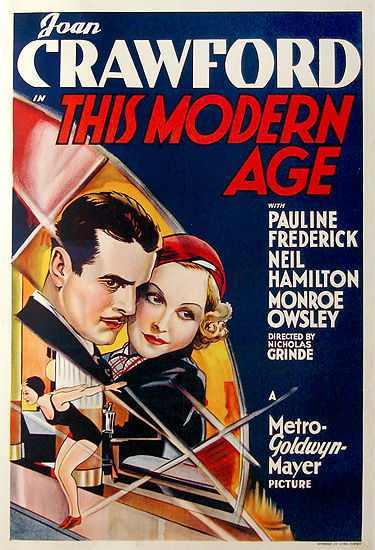
Above: Australian one-sheet.
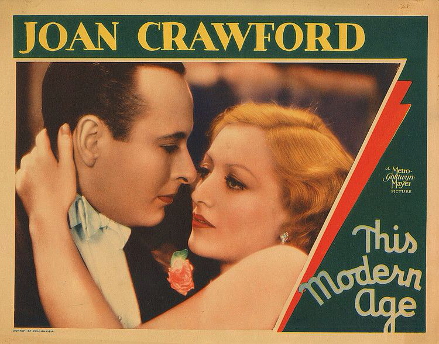
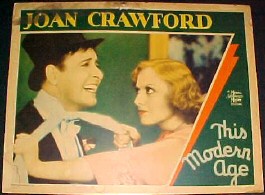



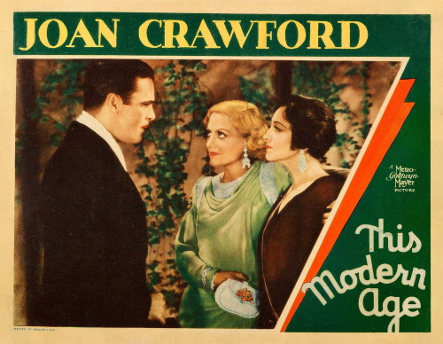
Above: US lobby cards.
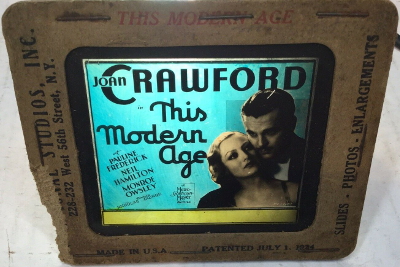
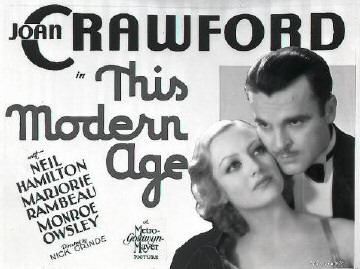
Above: A US glass lantern slide and early US publicity card (note that Rambeau rather than Frederick is in the credits).
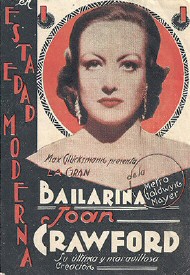
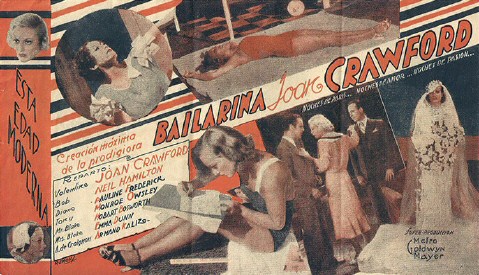

Above:
A herald from Uruguay.
Below:
A herald from Bombay, India.
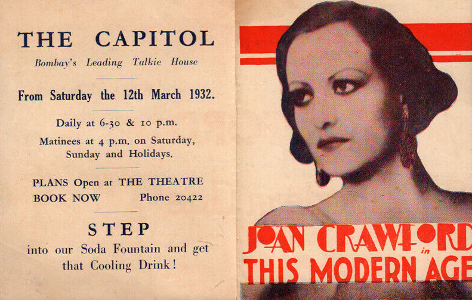
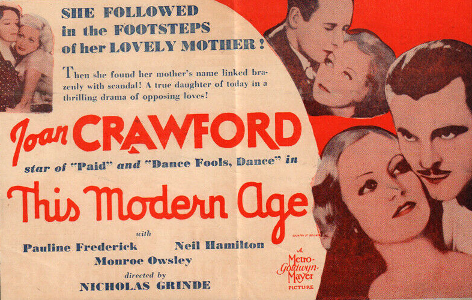

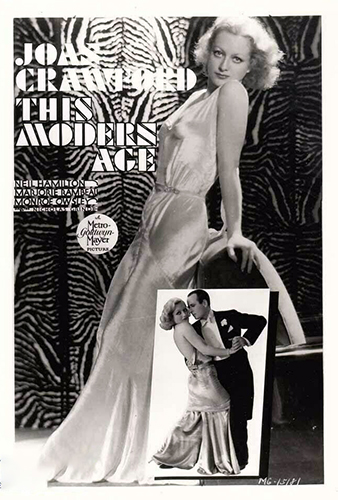

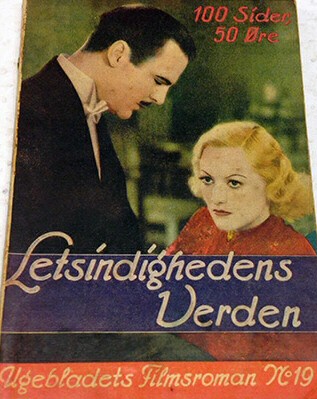
Above: Program cover (unknown country), MGM publicity artwork, US window card, and Danish novelization cover.
Below: A US handbill (left) and US newspaper ads.
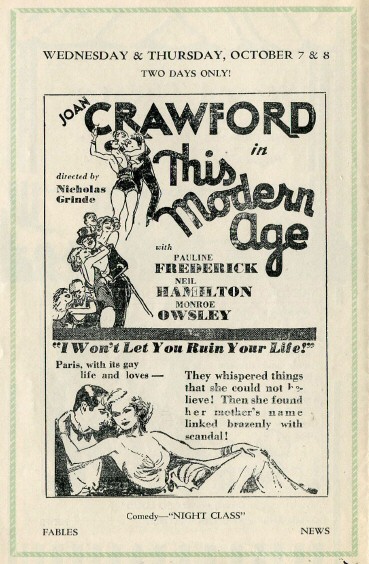


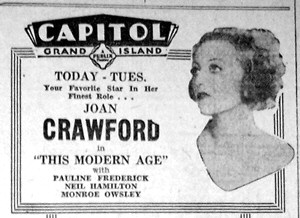


Below: San Rafael, California, marquee for This Modern Age.
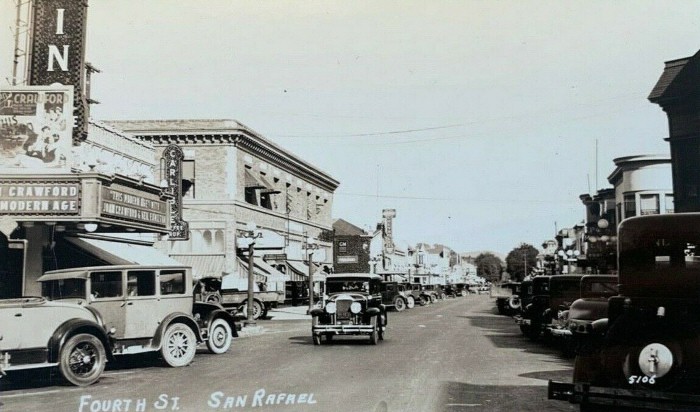
Below: Costume sketch by Adrian.
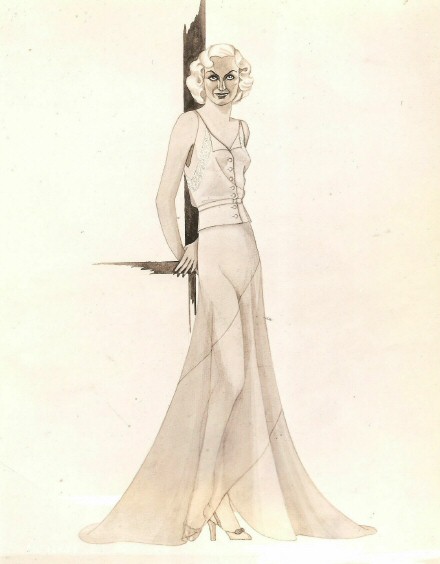

The Best of Everything
